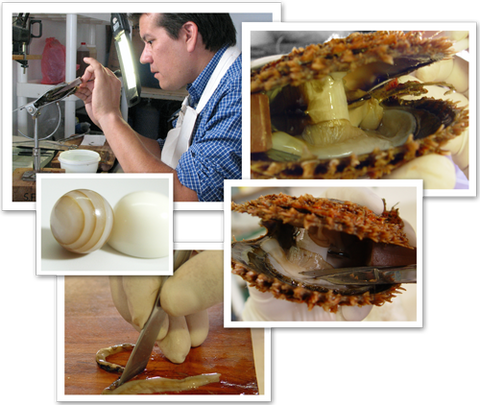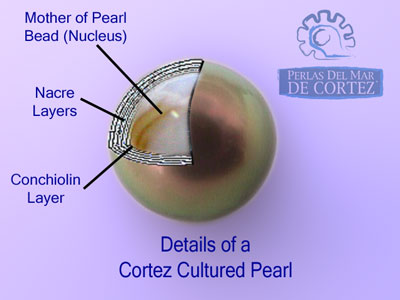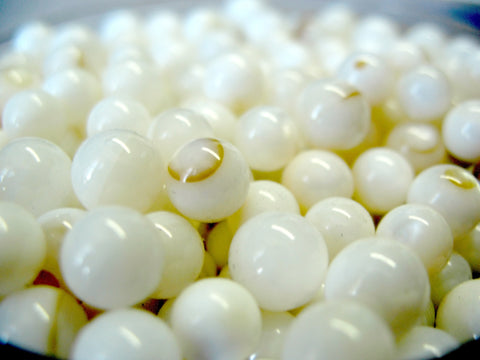The technique used to "culture" salt-water pearls is known worldwide as the "Mise-Nishikawa Method" and sometimes also as the "Part-of-the-cells technique Patent". The act of using this technique is known or referred to as the "Pearl Seeding" or "Pearl Grafting" Operation.
The basis of this technique (attributed to Japanese researchers Mise and Nishikawa) can be found in the work of Australian researcher William Saville Kent -who was commissioned to study Australia's great barrier reef- and who formulated the "pearl sac theory", which is the basis for understanding the process of bio-mineralization in a mollusk's mantle: the biological process responsible for pearl formation.
The seeding operation is rather simple (to explain) but it requires great skill and patience from the technician. The procedure varies from farm to farm, from one pearl oyster species to another and sometimes even from technician to technician.
According to Japanese specialists, the "Winged Oysters" (genus Pteria) are "a nightmare to operate" and thus, they cannot grow loose cultured pearls. Down here at Perlas del Mar de Cortez we have been able to prove them wrong by producing cultured pearls utilizing our native "Rainbow-Lipped" (Pteria sterna) oyster. This is the only pearl farm of its kind in the planet.
The list of people that have contributed to the present state of pearl culture have been many and from many nationalities: Unknown Chinese Monks in the 8th Century (for primitive "Budha" half-pearls), Gastón Vivès (Mexican) in the late 19th century (for Commercial Pearl Oyster Culture), William Saville Kent (Australian) in 1893 (for discovering the "pearl sac theory"), Kokichi Mikimoto in 1914 (for starting the modern pearl culture era), Tatsuhei Mise and Dr. Nishikawa in 1904 (for the patent of the "Mise-Nishikawa method"), and C. Denis George (Australian) for his work for helping to promote pearl culture development and being the first Gaijin (non-japanese) pearl technician.

Thanks to researchers and businessmen like them, owning pearls is a reality...and not a dream reserved just for Kings and Queens.
The Grafting Operation
The first step in the operation is to open-up the pearl oysters, but -hopefully- without killing them. Most technicians employ inverse steel pliers to force open their pearl oysters. Forcing open the oysters causes much mortality (depending on the species, anywhere from 30 to 70%).
Our company’s proprietary method lowers our mortality to only 0%, and once open we can proceed to perform the delicate operation.
But first, we need a "donor" oyster to obtain mantle tissue cells (the mantle is a thin, skin-like organ, responsible for the secretion of nacre or "mother-of-pearl shell"). We will cut away a strip of mantle tissue and then cut it up into small squares. These little pieces of mantle tissue will then be known as grafts.

Next, we must place the recipient oyster on a special stand, and an incision is made in the soft body of the oyster. Through this incision, we will insert a long and slender steel probe, and we will make a tunnel inside the animal's body mass, but always avoiding delicate organs: the heart, liver and pancreas, stomach and intestines).
At the end of this tunnel, we will find an organ usually referred as "the pearl sac" (keep in mind that the real "pearl sac" is actually a "tunic" made out of epithelial -or nacre secreting- mantle cells), made up of both gonad and connective tissues. This is the most appropriate place -within the animal- to grow the cultured pearl, this is due to the fact that it is both big enough to allocate the nucleus (and future cultured pearl) and it also receives many nutrients from the body.
Inside this pearl sac, we will introduce one spherical shell bead or nucleus. These beads are quite special for many reasons: they are obtained from the shells of freshwater mussels (family Unionidae) from the Mississippi River and its many tributaries. Those mussels are quite capable of making freshwater pearls, and their shells are -of course- made of mother-of-pearl shell, which makes them most appropriate for pearl culture.
Finally, comes the piece of mantle tissue, the graft must be placed alongside the bead. If all goes well (the animal survives, doesn't spit out the bead, etc.) the little piece of tissue will "graft" itself to the surrounding tissues, it will grow around the sphere and then will begin coating it up with microscopic layers of nacre (depositing anywhere from 1 to 3 layers daily).

After a wait of -at least- one year and a half (18 months) or up to two years (26 months), the coating of nacre on top of the shell bead should at least be between 1.2 and up to 3.0 mm. Thus, a shiny, beautiful and colorful Cortez pearl will finally be born unto the world.


